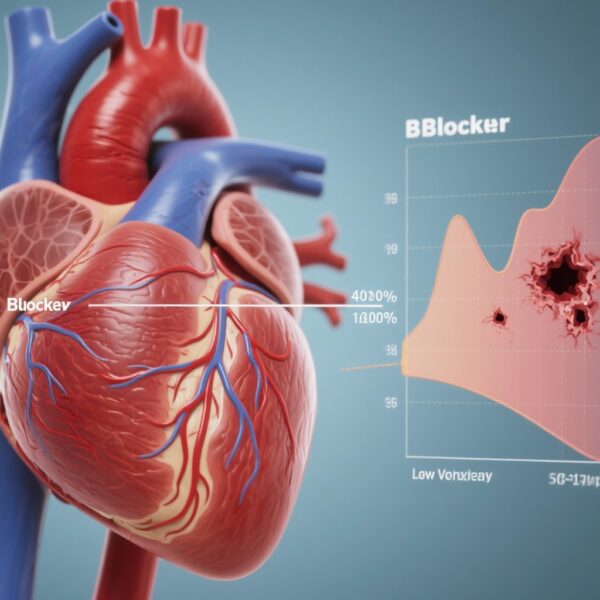Highlight
- Intensive systolic blood pressure control (<120 or <130 mm Hg) significantly reduces major cardiovascular events compared to standard targets.
- Absolute cardiovascular risk reduction is approximately 1.7%, balanced by about 1.8% increased risk of adverse events including hypotension and renal complications.
- Net clinical benefit favors intensive blood pressure lowering, supporting guideline recommendations despite increased harms.
- Benefit-harm profile remains favorable across diverse patient populations, with a median follow-up of over three years.
Study Background
Hypertension remains a leading modifiable risk factor for cardiovascular disease worldwide, profoundly impacting morbidity and mortality. While recent guidelines advocate for more intensive blood pressure (BP) lowering, targeting systolic BP levels below 130 or even 120 mm Hg, uncertainty persists about the overall balance of benefits and harms associated with such strategies. Intensive BP control reduces risks of myocardial infarction, stroke, and heart failure, yet raises concerns regarding adverse events—particularly hypotension, syncope, and kidney-related complications. Individual-level data analyses of randomized controlled trials are essential to precisely quantify this benefit-harm trade-off and inform nuanced clinical decision-making.
Study Design
This comprehensive post-hoc pooled analysis incorporated individual participant data from six major randomized controlled trials (ACCORD BP, SPRINT, ESPRIT, BPROAD, STEP, CRHCP), collectively enrolling 80,220 participants. Inclusion criteria for these studies included randomized comparisons of intensive systolic blood pressure targets (<120 or <130 mm Hg) against standard treatment targets (<140 mm Hg or <150 mm Hg for older adults), enrollment exceeding 2,000 participants, standardized adverse event reporting, and availability of participant-level data.
Participants’ median age was 64 years, with balanced sex representation. A majority were of Asian ethnicity (82.6%), followed by White individuals (10.1%). Intervention arms were assigned following the individual trial protocols, with careful adjudication of cardiovascular outcomes and treatment-related harms over a median follow-up of 3.2 years.
The primary benefit endpoint was a composite of myocardial infarction, stroke, heart failure, and cardiovascular death. Harm outcomes comprised treatment-related adverse events—hypotension, syncope—and renal events. Analytical methods employed Bayesian hierarchical models under an intention-to-treat framework, allowing estimation of absolute and relative risks along with net clinical benefit metrics incorporating weighted harm assessments.
Key Findings
The pooled dataset revealed that intensive BP control reduced the incidence of major cardiovascular events from 7.1% to 5.3%, corresponding to a hazard ratio of 0.76 (95% credible interval [CrI]: 0.72–0.81; p<0.0001). This translated into an absolute risk reduction of 1.73% (95% CrI: 1.65–1.81), with a number needed to treat (NNT) of 58 (95% CrI: 55–61) to prevent one major cardiovascular event.
Conversely, intensive control increased adverse events by an absolute 1.82% (95% CrI: 1.63–2.01), with a number needed to harm (NNH) of 55 (95% CrI: 49–61). These harms included predominantly hypotension and syncope episodes, as well as kidney-related complications such as declines in renal function. Importantly, the net clinical benefit—balancing cardiovascular risk reduction against adverse event increase—remained positive at 1.14 (95% CrI 1.03–1.25), even when renal events were accounted for (net benefit 1.13, 95% CrI 1.01–1.24).
The benefit-harm balance was consistent across patient subgroups defined by age, sex, and ethnicity, suggesting broad applicability. Bayesian hierarchical modeling enabled integration of trial heterogeneity while maximizing statistical power.
Expert Commentary
The findings affirm that targeting more intensive systolic BP levels yields meaningful cardiovascular protection despite a rise in treatment-related adverse events. This represents an important reassurance to clinicians hesitant about aggressive BP lowering due to safety concerns. The net benefit supports contemporary hypertension guidelines advocating for BP targets below 130 mm Hg in most patients, though the balance is nuanced on an individual basis.
Limitations include the predominance of Asian participants, which may influence generalizability to other populations. Also, longer-term renal outcomes beyond median 3.2 years warrant further investigation. The careful adjudication of harms and use of Bayesian methods enhance the robustness of conclusions.
Biologically, intensive BP lowering reduces vascular stress and atherosclerotic progression, while occasionally precipitating hypoperfusion-related events and renal hypoxia, explaining the observed benefit-harm trade-off. Shared decision-making incorporating patient preferences about risk tolerance remains essential.
Conclusion
This individual participant data meta-analysis conclusively shows that intensive blood pressure control reduces major cardiovascular events with an acceptable increase in adverse events, yielding a positive net clinical benefit. These results reinforce current guideline recommendations promoting intensive BP targets to maximize cardiovascular and renal protection. Clinicians should individualize treatment intensity considering patient comorbidities, age, and risk of adverse events but can be reassured by evidence that the benefit-harm profile of intensive BP management is generally favorable.
Funding and ClinicalTrials.gov
Funding was provided by the National Key Research and Development Program and the Ministry of Science and Technology of China, alongside multiple Chinese scientific foundations. Trial registrations correspond to those of included trials (e.g., SPRINT, ACCORD BP).
References
Guo X, Sun G, Xu Y, Zhou S, Song Q, Li Y, et al. Benefit-harm trade-offs of intensive blood pressure control versus standard blood pressure control on cardiovascular and renal outcomes: an individual participant data analysis of randomised controlled trials. Lancet. 2025 Sep 6;406(10507):1009-1019. doi: 10.1016/S0140-6736(25)01391-1. PMID: 40902616.
Additional guideline references:
1. Whelton PK, Carey RM, Aronow WS, et al. 2017 ACC/AHA/AAPA/ABC/ACPM/AGS/APhA/ASH/ASPC/NMA/PCNA Guideline for the Prevention, Detection, Evaluation, and Management of High Blood Pressure in Adults. Hypertension. 2018;71(6):e13-e115.
2. Williams B, Mancia G, Spiering W, et al. 2018 ESC/ESH Guidelines for the management of arterial hypertension. Eur Heart J. 2018;39(33):3021-3104.


